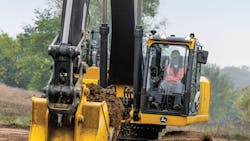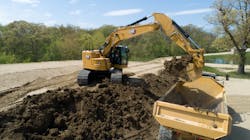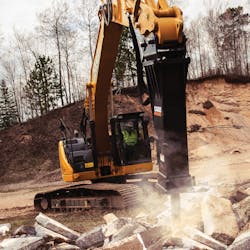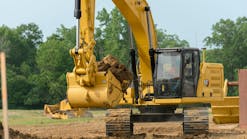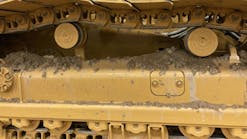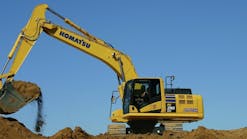Manufacturers of excavators in the 60,000- to 80,000-pound class are offering different technology levels, price points, or "tiers"--depending on an OEM's particular parlance--for the same size machine. In other words, there can be up to three different versions of the same excavator.
Read also: The top excavators of 2023.
And none of them has to do with long reach or anything that dramatically affects appearance.
The differences are mostly inside in terms of the level of technology and other bells and whistles or lack thereof. Fuel efficiency and hydraulics also play a role.
Cat excavators now in GC versions
Caterpillar was the first to take the plunge on multiple versions with its "GC" excavators.
Although Cat started the trend below the 60,000- to 80,000-pound category, it now touches the Cat 330 that weighs in at 67,900 pounds.
The company's marketing points out that GC products are aimed at small- to medium-sized customers looking for best-in-class machines that are simply durable, reliable, fuel competitive, and economical. Cat has touted low cost per hour, simple maintenance, and extended service intervals as GC hallmarks for Cat excavators. They've also mentioned "fuel competitiveness from lower engine speeds, improved fuel efficiency, and effective hydraulic functionality that delivers seamless hydraulic impulses."
The point is a smooth, simple, efficient machine at a lower price point. Presumably, Cat is also trying to lure entry-level customers to the brand. There's been a similar strategy with Cat's Yellowmark parts.
"The GC excavator offering has been very well received in the market and continues to gain momentum," says Brian Stellbrink, senior market professional for Caterpillar, who says the strategy will continue for Cat excavators as well as other product offerings such as wheel loaders and motor graders).
"The GC excavators have been popular with customers that don’t necessarily need a machine with each and every feature, nor the full suite of standard technology," he says. "For some, they need a solid, reliable excavator with performance matched to their job, all backed up with excellent dealer support. In those cases, the GC offering can very well meet their needs. This offering has also been well received in rental fleets and governmental business. The key is we have, and will continue to offer, different choices to best meet the needs of the industry."
Deere excavator tiers
Deere's "Performance Tiering" strategy adds a third level. The strategy is meant to deliver a range of products at different levels of capability and user experience.
First introduced on wheel loaders and then moved to excavators (250 P-tier, 300 P-tier, and 345 P-tier so far in the 60,000- to 80,000-pound size class), Performance Tiering supports customers by providing machine solutions built for various applications and jobs to enhance profitability and efficiency. It provides three tiers of machines—G tier, P tier, and X tier.
“Every job site is unique, and customers want machine solutions that can be personalized to meet their diverse needs, including performance, price, and comfort,” says Jason Daly, global director, production systems, technology and marketing, John Deere. “By offering three tiers, customers can move up or down the spectrum to find the right mix of features, performance, and innovation for their business and application.”
Deere defines its levels this way: premium high-tech features, high production, and light- to medium-duty units, in that order.
- The premium X-tier models are built with the most innovative John Deere technology and features, delivering the highest levels of productivity, efficiency, and customer experience.
- P-tier models are designed to produce at high levels, day in and day out. Advanced features deliver exceptional performance, efficiency, comfort, and service life in demanding, high-production applications.
- The G-tier models are practically equipped and economical, providing proven capabilities with the reliability and ruggedness expected from John Deere. These machines are ideal for customers in need of a reliable machine to complete common light- to medium-duty tasks.
"Our Performance Tiering Strategy enables us to offer solutions representing a spectrum of different capability and specification levels at price points that customers are willing to pay," says Justin Steger, solutions marketing manager, John Deere.
"While price is certainly a factor, it's not the only factor, which creates the need for multiple tiers. These products are designed to meet distinct customer and operation requirements in terms of application life, performance, serviceability, comfort, and innovation. Under the John Deere brand, we will be offering solutions ranging from value-focused through performance-focused products. Customers can expect the same level of sales, service, and support from their John Deere dealer regardless of which tier is right for them."
So far, no other OEMs have taken the plunge to offer multiple versions of the same machine with different prices and feature levels, unless one counts Volvo Construction Equipment (premium priced) and its SDLG brand (value priced).
Excavator acquisition trends
There are a number of other trends in the category, including increased use and sophistication of grade-control technology to help operators perform better.
"Moving from G Series to P-tier in the 60,000- to 80,000-pound size class, we continue to offer SmartGrade on the 350-size machine, and now offer SmartGrade on the 380 P-tier as well," says Steger. "Customers can choose from 2D Guidance, 2D SmartGrade ready control, or full 3D SmartGrade integrated and calibrated from the factory. John Deere also offers upgrade kits depending on the level of technology customers need today, and what they could potentially need in the future. Grade control technology will benefit fleet managers by getting the most productivity and accuracy out of their equipment. "
Deere says that in a test comparing manual operation to SmartGrade operation, using novice and experienced operators, the results were significant. Novice operators were 90 percent more accurate using SmartGrade and completed the job 30 percent faster. In the same test, an experienced operator was 58 percent more accurate and completed the job 10 percent faster.
Caterpillar's Stellbrink cites the key trends for machines in this size range as technology, attachment versatility, and compact radius platforms.
"All of these are hot trends that are enabling contractors to be more efficient and make the best use of the limited valuable resources they have," Stellbrink says. "Standard technology of Cat Next Gen excavators is a prime example. Grade, Payload, and E-Fence features help contractors work more efficiently and get more work done, more safely, and at a lower cost. [They also help] address continued labor shortages in the industry by helping operators of all skill levels be more confident and more proficient when it comes to excavation tasks and right loading trucks, as an example. Technology also helps in the recruitment and retention of operators.
As for attachments, Stellbrink says Cat is seeing an increased use of tiltrotator attachments and hydraulic connect quick couplers. Cat offers its TRS tiltrotator for all models within the 60,000- to 80,000-pound size class.
"The clear benefits are related to significantly less movement and repositioning of the excavator," Stellbrink says. "It’s simple really; less machine movements saves time, saves fuel, increases production, and lowers cost. The tiltrotator can also be used in conjunction with a hydraulic connect quick coupler. This enables the contractor to make quick work tool changes from the safety and comfort of the cab. A full range of tools can be quickly changed, from basic buckets to the most advance hydraulic work tools. Again, it saves time, saves fuel, increases production, and lowers cost."
Fuel savings is also top of mind for Hitachi. Hitachi, which had a joint venture agreement with Deere on excavators for many years, is now on its own, another relatively recent development in the category.
Its 80,000-pound ZX350LC-6 HP has a new three-pump TRIAS II hydraulic system designed to reduce fuel consumption and increase efficiency. The third pump contributes to several of the main actuators, giving priority to the swing circuit. Fine-tuned control valve spools, multiple pressure sensors, and computer-controlled solenoid valves maximize efficiency and multifunctional productivity without sacrificing fuel economy. With losses inherent to all hydraulic systems, the TRIAS II hydraulic system was engineered to reduce losses that occur during spool or valve operation.
A final trend is the increased use of compact radius excavators up into this size range," Stellbrink says. "For example, Caterpillar offers a 325 (60,000-pound area) and a 335 (80,000 pound). They are large, high-performance machines yet nimble for tightly spaced job sites such as road construction, underground utility, site work, etc. These machines have excellent lifting capability, large comfortable cabs, full range of technologies, and all the other features one would expect from their standard radius counterparts."
Deere points to improvements in its P-Tier excavators as responding to trends in the areas of durability and operating costs.
"Our 250/300/350 P-Tier excavators now have a grease lubricator at the arm tip (arm to bucket joint) for better distribution of grease in this critical joint," Steger says. "The design injects grease from the center of the joint and flows to the outside to push contaminants outward, resulting in improved joint life. We've also made improvements to the boom bushings to help control cost from everyday operation of the excavator."
In addition, the 250/300/350 P-tier excavators now use electronic cooling fans. "These fans, compared to a hydraulically driven cooling fan on the previous G Series, are less of a load on the engine," Steger explains. "This results in up to 7 percent fuel efficiency improvements compared to the G Series, depending on model and application. These fans are also easier to service and replace if needed, which will provide value to fleet managers."
With lead times long and new equipment prices high, OEMs have seen more leasing. Most OEMs did not wish to comment on excavator delays for this article, with a number echoing what Deere's Steger says: "Lead times will vary by model, configuration, and dealer. Customers should visit their dealer to get the most accurate lead times."
As for leasing, "It's really up to the fleet manager to make the best decision given their capital allocation and availability of the equipment they need," Steger says. "As new machine prices rise, supply and demand have also impacted used machine prices. It's important for fleet managers to consult with the local dealer to see what's available, what may be coming, and if it makes sense to buy new or used, matched with the appropriate warranty package."
"There is certainly different equipment purchase options and no single approach for everyone," Cat's Stellbrink says. "Dealers certainly do an excellent job inspecting and certifying used equipment and can be a viable option for some contractors. I would also urge contractors to seriously consider a new excavator to ensure the latest features and full support. This way they can be assured they have the most current and efficient machine for the job to help maximize the return on their investment from day one. With the used price levels observed in recent years, some may also be surprised that the difference between used and new may not be as large as originally thought."
To maintain both uptime and residual value, Stellbrink and Steger are united on the value of maintenance.
"Stay on top of maintenance and repairs; that means proper training and rigorous daily inspections by field personnel," Stellbrink says. "Using genuine parts that have been strictly designed to maximize the performance and life the machine. [Have a] close partnership with their local dealer for help and guidance, whether it’s maintenance and repair services, operator training, or extended warranty coverage. Also, operator training and operational best practices to not only get the most out of the machine but also to do it in a way that maximizes the life of the machine."
"Beyond [maintenance and service, use], our connected machines via JDLink enable John Deere Connected Support," Steger says. "Dealers use Expert Alerts based on data from thousands of connected machines to proactively address conditions that may otherwise likely lead to downtime. Your dealer can also monitor machine health and leverage remote diagnostics and programming capability to further diagnose problems and even update machine software without a time-consuming trip to the job site. Whether it's parts, service, or support, our John Deere dealers provide a suite of customizable lifecycle solutions to help customers get the most out of their machines."
